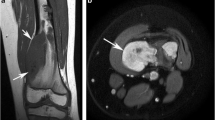Abstract
Objective
To describe the MRI features of paediatric conventional central chondrosarcoma (CC-CS) and correlate with histological grade.
Materials and methods
A retrospective review of children/adolescents with histologically confirmed CC-CS. Data collected included age, sex, skeletal location, and histology from needle biopsy or resection, which was classified as atypical cartilaginous tumours/grade 1 CS (ACT/Gd 1 CS), high-grade chondrosarcoma (HGCS), and dedifferentiated chondrosarcoma (DD-CS). MRI studies were reviewed independently by 2 radiologists blinded to the histology grade, who graded the tumours as ACT/Gd 1 CS, HGCS, and DD-CS based on MRI features.
Results
The study included 7 males and 10 females with mean age 13.9 years (range 6–18 years). Tumours were located in the femur (n = 6), humerus (n = 3), tibia, ilium, scapula, and ulna (n = 1 each), and the small bones of the hands or feet (n = 4). Final histology grade was ACT/Gd 1 CS in 15 cases and HGCS in 2 (both grade 1 CS with focal transition to grade 2), 15 based on surgical specimens, 1 based on open biopsy, and 1 on needle biopsy alone. Predicted MRI grade for the 2 readers was ACT/Gd 1 CS in 11 cases each and HGCS in 6 cases each, indicating a mismatch between predicted MRI grade and histological grade in 8 (47%) cases (4 cases with one reader mismatch and 4 cases with both).
Conclusions
MRI findings in paediatric CC-CS may be misleading, showing features suggestive of HGCS 7 of 17 (41.2%) of cases. This should be taken into consideration when planning surgical treatment.







Similar content being viewed by others
References
Whelan JS, Davis LE. Osteosarcoma, chondrosarcoma, and chordoma. J Clin Oncol Off J Am Soc Clin Oncol. 2018;36:188–93.
Francis M, Dennis N, Charman J, Lawrence G, Grimer R. Bone and soft tissue sarcomas. UK incidence and survival: 1996 to 2010. [Internet]. National Cancer Intelligence Network; 2013. Available from: http://www.ncin.org.uk/view?rid=2353
Soft Tissue and Bone Tumours. WHO classifications of tumours [Internet]. 5th ed. International Agency for Research on Cancer, World Health Organisation, International Academy of Pathology, WHO Classification of Tumours Editorial Board.; 2020. Available from: https://publications.iarc.fr/588
Mosier SM, Patel T, Strenge K, Mosier AD. Chondrosarcoma in childhood: the radiologic and clinical conundrum. J Radiol Case Rep. 2012;6:32–42.
Wu A-M, Li G, Zheng J-W, Chen C-H, Chen D, Qiao Z-G, et al. Chondrosarcoma in a paediatric population: a study of 247 cases. J Child Orthop. 2019;13:89–99.
Huvos AG, Marcove RC. Chondrosarcoma in the young. A clinicopathologic analysis of 79 patients younger than 21 years of age. Am J Surg Pathol. 1987;11:930–42.
Gambarotti M, Righi A, Picci P, Bertoni F, Manfrini M, Donati DM, et al. Paediatric chondrosarcomas: a retrospective review of 17 cases. Histopathology. 2016;68:1073–8.
Puri A, Gulia A, Kurisunkal VJ, Sukumar V, Rekhi B. Chondrosarcomas in adolescents: are they different? J Pediatr Orthop Part B. 2019;
Shemesh SS, Acevedo-Nieves JD, Pretell-Mazzini J. Treatment strategies for central low-grade chondrosarcoma of long bones: a systematic review of the literature and meta-analysis. Musculoskelet Surg. 2018;102:95–109.
Dierselhuis EF, Goulding KA, Stevens M, Jutte PC. Intralesional treatment versus wide resection for central low-grade chondrosarcoma of the long bones. Cochrane Database Syst Rev. 2019;3:CD010778.
Gerrand C, Athanasou N, Brennan B, Grimer R, Judson I, Morland B, et al. UK guidelines for the management of bone sarcomas. Clin Sarcoma Res. 2016;6:7.
Oliveira I, Chavda A, Rajakulasingam R, Saifuddin A. Chondral tumours: discrepancy rate between needle biopsy and surgical histology. Skelet Radiol. 2020;49:1115–25.
Yoo HJ, Hong SH, Choi J-Y, Moon KC, Kim H-S, Choi J-A, et al. Differentiating high-grade from low-grade chondrosarcoma with MR imaging. Eur Radiol. 2009;19:3008–14.
Douis H, Singh L, Saifuddin A. MRI differentiation of low-grade from high-grade appendicular chondrosarcoma. Eur Radiol. 2014;24:232–40.
Yoshimura Y, Isobe K, Arai H, Aoki K, Kito M, Kato H. Preoperative radiographic and histopathologic evaluation of central chondrosarcoma. Arch Orthop Trauma Surg. 2013;133:1225–31.
Fritz B, Müller DA, Sutter R, Wurnig MC, Wagner MW, Pfirrmann CWA, et al. Magnetic resonance imaging-based grading of cartilaginous bone tumors: added value of quantitative texture analysis. Investig Radiol. 2018;53:663–72.
Fayad LM, Ahlawat S, Khan MS, McCarthy E. Chondrosarcomas of the hands and feet: a case series and systematic review of the literature. Eur J Radiol. 2015;84:2004–12.
Deckers C, Steyvers MJ, Hannink G, Schreuder HWB, de Rooy JWJ, Van Der Geest ICM. Can MRI differentiate between atypical cartilaginous tumors and high-grade chondrosarcoma? A systematic review. Acta Orthop 2020;1–8.
Puri A. Chondrosarcomas in children and adolescents. EFORT Open Rev 2020;5:90–5.
Young CL, Sim FH, Unni KK, McLeod RA. Chondrosarcoma of bone in children. Cancer. 1990;66:1641–8.
Bierry G, Kerr DA, Nielsen GP, Rosenberg AE, Huang AJ, Torriani M, et al. Enchondromas in children: imaging appearance with pathological correlation. Skelet Radiol. 2012;41:1223–9.
Rana RS, Wu JS, Eisenberg RL. Periosteal reaction. AJR Am J Roentgenol. 2009;193:W259–72.
Choi B-B, Jee W-H, Sunwoo H-J, Cho J-H, Kim J-Y, Chun K-A, et al. MR differentiation of low-grade chondrosarcoma from enchondroma. Clin Imaging. 2013;37:542–7.
De Coninck T, Jans L, Sys G, Huysse W, Verstraeten T, Forsyth R, et al. Dynamic contrast-enhanced MR imaging for differentiation between enchondroma and chondrosarcoma. Eur Radiol. 2013;23:3140–52.
Douis H, Parry M, Vaiyapuri S, Davies AM. What are the differentiating clinical and MRI-features of enchondromas from low-grade chondrosarcomas? Eur Radiol. 2018;28:398–409.
Author information
Authors and Affiliations
Corresponding author
Ethics declarations
The study was approved by the local Research and Innovation Centre of The Institute of Orthopaedics under the Integrated Research Application System number 262826, with no requirement for informed patient consent.
Conflict of interest
The authors declare that they have no conflict of interest.
Additional information
Publisher’s note
Springer Nature remains neutral with regard to jurisdictional claims in published maps and institutional affiliations.
Rights and permissions
About this article
Cite this article
Ardakani, A., Gikas, P., Khoo, M. et al. MRI-histopathological correlation in paediatric conventional central chondrosarcoma: a report of 17 cases. Skeletal Radiol 50, 711–721 (2021). https://doi.org/10.1007/s00256-020-03614-6
Received:
Revised:
Accepted:
Published:
Issue Date:
DOI: https://doi.org/10.1007/s00256-020-03614-6




